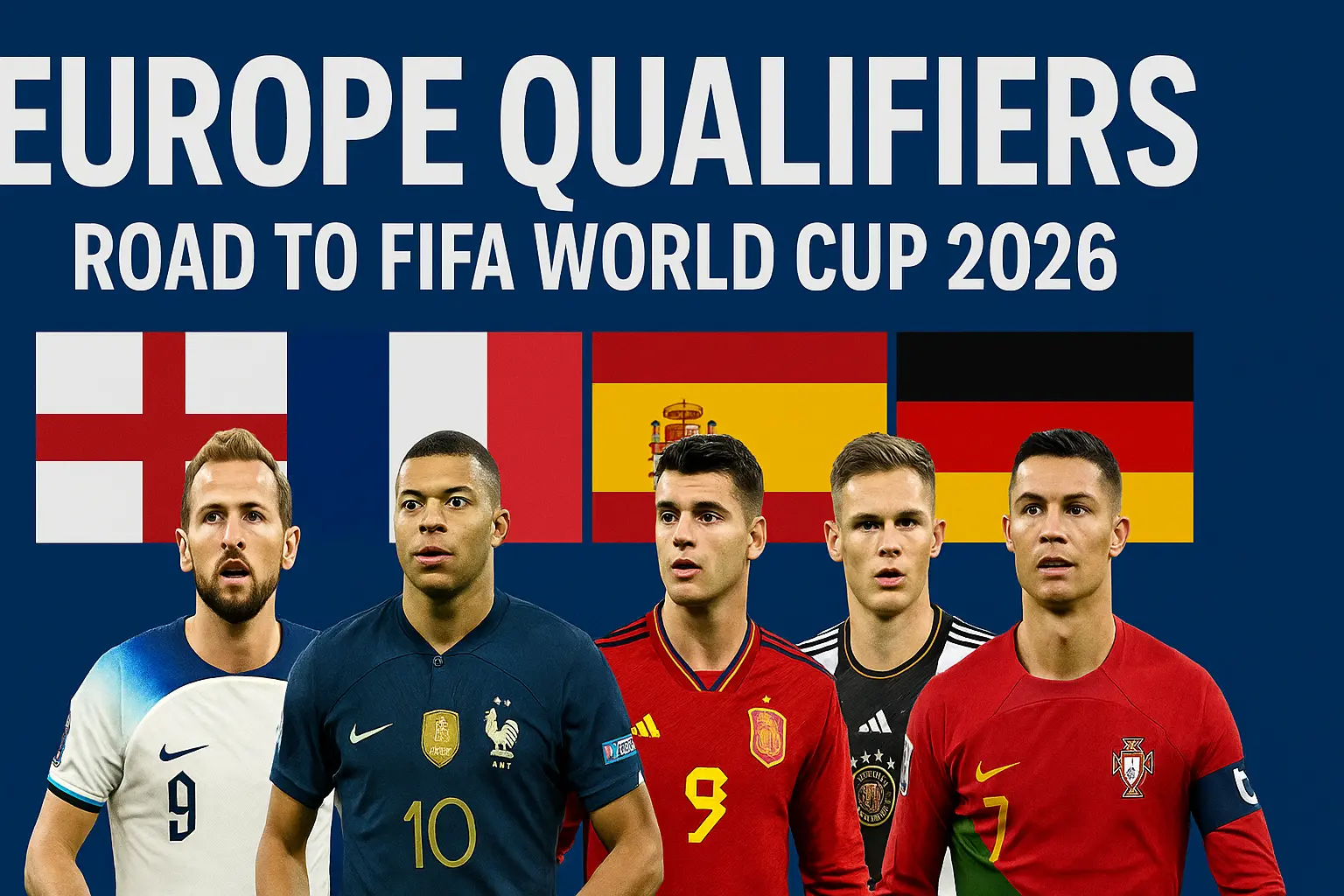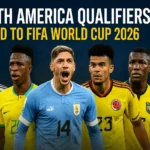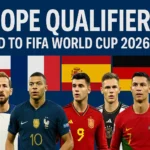From England’s composure to France’s brilliance – Europe prepares for football’s biggest stage
The countdown to the FIFA World Cup 2026 has begun, and Europe once again sits at the centre of the global football conversation.
With the tournament expanding to 48 teams, Europe will send a record 16 nations to North America — the largest representation from any continent in World Cup history.
From the dominance of England and France to the tactical evolution of Spain, Germany, Italy, and Portugal, the road to 2026 has been fierce, unpredictable, and full of drama. The Union of European Football Associations (UEFA) qualifiers have showcased the continent’s depth and talent, as emerging teams such as Norway, Serbia, and Hungary challenge the traditional hierarchy.
🧭 UEFA Qualification Format
Europe’s qualification structure for the World Cup 2026 began in March 2025 and follows a detailed format designed to balance competition and merit:
1. 12 groups of four or five teams each.
2. Group winners automatically qualify for the World Cup.
3. Runners-up advance to the UEFA play-offs.
4. Four Nations League group winners who didn’t finish top two join the play-offs.
5. Four more European teams qualify via the play-offs in March 2026.
➡️ In total, 16 European nations will feature in the FIFA World Cup 2026 — a historic milestone for UEFA.
This system ensures that both established giants and ambitious underdogs have a path to the world stage.
📊 Current Standings and Likely Qualifiers
As of late 2025, several European heavyweights have already booked or virtually secured their tickets to North America:
FIFA Rank (2025)*
Nation
Qualification Status
#4
🇫🇷 France
Group B leaders – near certain qualification
#5
🇬🇧 England
First European team officially qualified
#7
🇩🇪 Germany
Group C front-runner – consistent form
#8
🇪🇸 Spain
Dominating Group D with youthful energy
#10
🇮🇹 Italy
Battling Croatia for automatic spot
#11
🇵🇹 Portugal
On course to win Group F comfortably
Approximate FIFA World Ranking – October 2025.
Chasing the remaining slots are Croatia, Netherlands, Denmark, Switzerland, Norway, and Serbia, each aiming to avoid the play-off lottery.
🌟 Star Players Defining the Campaign
🇬🇧 England – Clinical and Composed
• Harry Kane (Bayern Munich) – England’s captain and all-time top scorer.
• Declan Rice (Arsenal) – Defensive control and leadership in midfield.
• Phil Foden (Manchester City) – Creative heartbeat of Southgate’s system.
England became Europe’s first qualifier, combining tactical maturity with squad depth unseen since 2018.
🇫🇷 France – Power, Pace, and Precision
• Kylian Mbappé (Paris Saint-Germain) – Europe’s most feared forward.
• Antoine Griezmann (Atletico Madrid) – The playmaker connecting midfield to attack.
• Eduardo Camavinga (Real Madrid) – Youthful energy driving France’s balance.
France’s wealth of talent makes them overwhelming favourites to lift the trophy again.
🇪🇸 Spain – Youth Revolution
• Pedri (Barcelona) – Tactical intelligence beyond his years.
• Gavi (Barcelona) – Fierce competitor with relentless pressing.
• Álvaro Morata (Atletico Madrid) – Veteran finisher providing experience.
Spain’s mix of youth and possession-based dominance keeps them among Europe’s most elegant teams.
🇩🇪 Germany – Rebuilding with Purpose
• Jamal Musiala (Bayern Munich) – Germany’s creative engine.
• Ilkay Gündoğan (Barcelona) – Veteran presence in midfield.
• Florian Wirtz (Leverkusen) – Emerging star reshaping German attack.
After a decade of transition, Germany are rebuilding their identity under new management.
🇵🇹 Portugal – Experience Meets Energy
• Cristiano Ronaldo (Al-Nassr) – Still decisive, still dangerous.
• Bruno Fernandes (Manchester United) – The team’s creative conductor.
• Rafael Leão (AC Milan) – Lightning pace and unpredictability.
Portugal’s combination of youth and veterans positions them as dark-horse contenders for the 2026 crown.
🔍 Key Trends Shaping UEFA 2026 Qualifiers
• Emerging Powerhouses: Norway with Erling Haaland and Martin Ødegaard, and Serbia with Dušan Vlahović, are closing the gap.
• Youth Movement: Europe’s under-25 stars dominate the spotlight, redefining the region’s playing style.
• Tactical Diversity: Pressing systems, inverted full-backs, and ball-control structures dominate the modern European game.
• Play-off Pressure: Second-placed teams face an unforgiving March 2026 route, ensuring every point counts.
⏱ Timeline and Key Dates
• Group Stage Ends: November 2025
• Play-Offs: March 2026 (semi-final + final)
• FIFA World Cup 2026: June 11 – July 19 2026 across USA, Canada, and Mexico
🏁 Conclusion
Europe’s qualification campaign for the FIFA World Cup 2026 captures everything that defines the continent’s football — precision, passion, and relentless competition.
From Kane’s leadership to Mbappé’s brilliance, and from Pedri’s creativity to Ronaldo’s longevity, this generation of European footballers is carrying the legacy of their predecessors while shaping a bold new future.
With 16 UEFA teams set to represent Europe in North America, the 2026 World Cup will once again be a showcase of European strategy, stamina, and style.
❓ Frequently Asked Questions (FAQ)
Q 1. How many European teams qualify for the FIFA World Cup 2026?
➡ Sixteen UEFA teams qualify — 12 direct from group winners and 4 via the March 2026 play-offs.
Q 2. When do the European qualifiers end?
➡ Group matches finish in November 2025, and the UEFA play-offs take place in March 2026.
Q 3. Which teams have already qualified?
➡ England has qualified first; France, Spain, Portugal, Germany, and Italy are on track to join.
Q 4. How does the UEFA play-off system work?
➡ Twelve runners-up plus four Nations League group winners play single-leg semi-finals and finals for the last four spots.
Q 5. Could smaller teams like Norway or Serbia qualify?
➡ Yes. Both are in strong positions and could reach either automatic or play-off qualification.
Q 6. Who are the top European players to watch in 2026?
➡ Kylian Mbappé, Harry Kane, Pedri, Bruno Fernandes, Rafael Leão, Jamal Musiala, and Erling Haaland headline the continent’s elite.
Q 7. Where will the World Cup 2026 be played?
➡ Across United States, Canada, and Mexico, with matches in 16 host cities.










